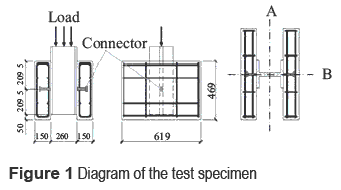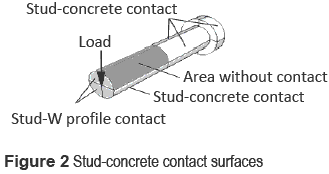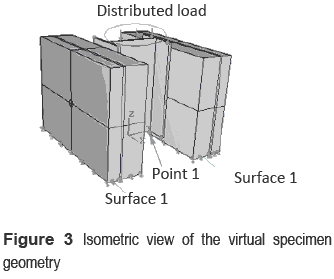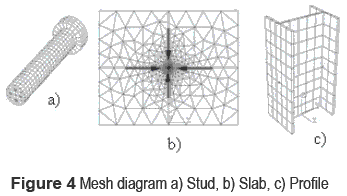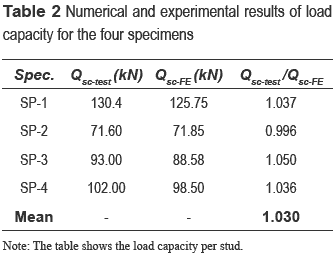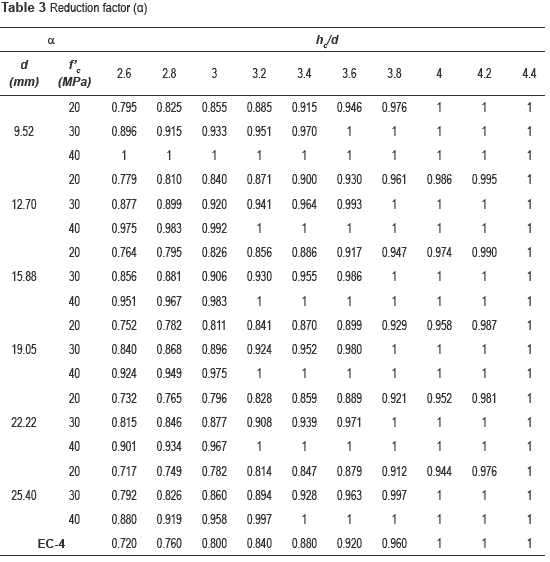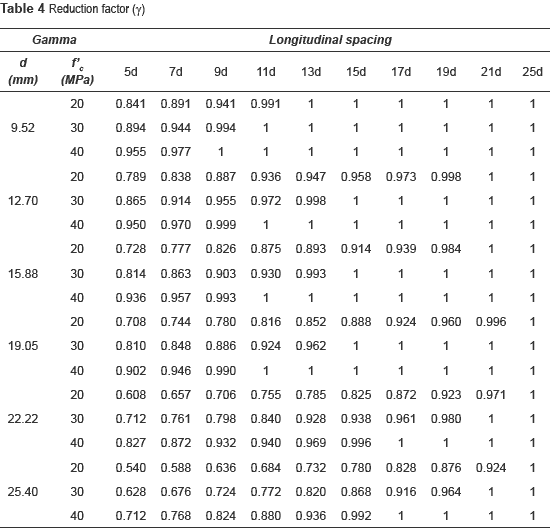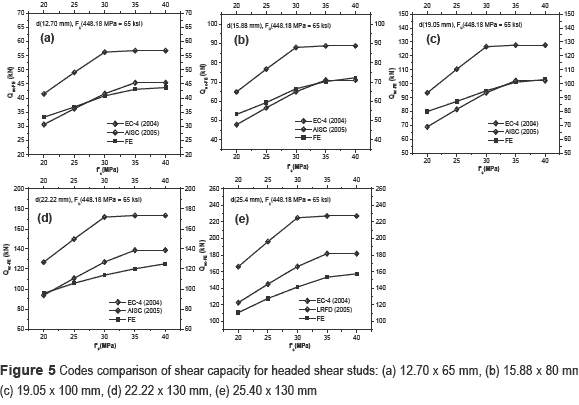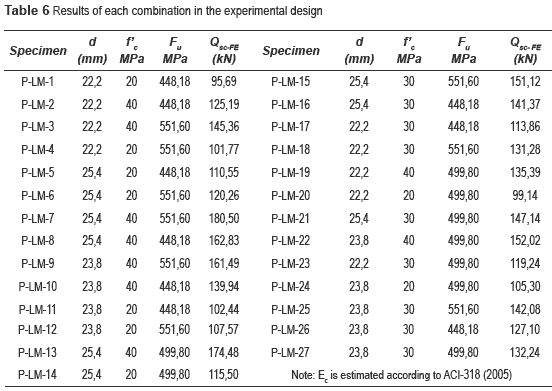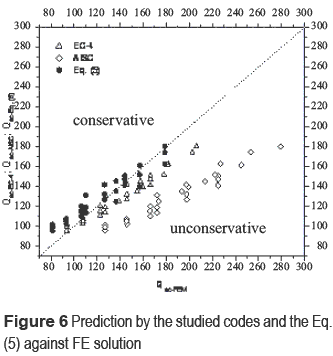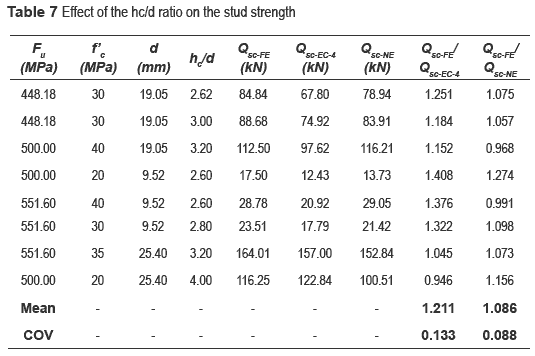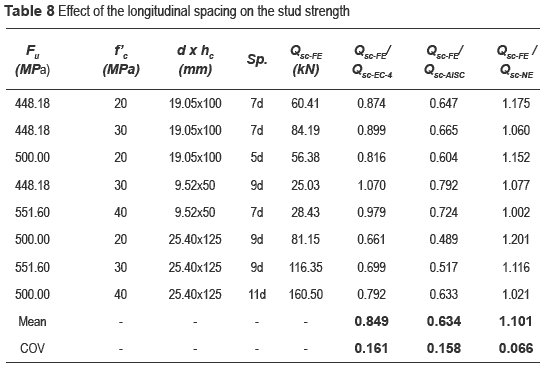Services on Demand
Journal
Article
Indicators
-
 Cited by SciELO
Cited by SciELO -
 Access statistics
Access statistics
Related links
-
 Cited by Google
Cited by Google -
 Similars in
SciELO
Similars in
SciELO -
 Similars in Google
Similars in Google
Share
Revista Facultad de Ingeniería Universidad de Antioquia
Print version ISSN 0120-6230
Rev.fac.ing.univ. Antioquia no.63 Medellín Apr./June 2012
ARTÍCULO ORIGINAL
Behavior and strength of welded stud shear connectors in composite beam
Comportamiento y resistencia de conectores tipo perno en vigas compuestas
Jorge Douglas Bonilla Rocha1*, Enrique Mirambell Arrizabalaga2, Rafael Larrúa Quevedo3, Carlos A. Recarey Morfa4
1Department of Mathematics. Universidad de Ciego de Ávila. Cuba.
2Department of Construction Engineering. Universitat Politecnica de Catalunya. Spain.
3Department of Civil Engineering. Universidad de Camagüey. Cuba. ''Department of Civil Engineering. Universidad Central de Las Villas. Cuba.
*Autor de correspondencia: teléfono: 53 + 33 + 207212, fax: 53 + 42 + 282014, correo electrónico: jorgedbr@informatica.unica.cu (J. Bonilla)
(Recibido el 23 de mayo de 2011. Aceptado el 23 de mayo de 2012)
Abstract
In this paper the behaviour of stud shear connectors in composite structures is analysed. The composite section is formed by steel profiles connected to solid concrete slabs. Some effective numerical models using the finite element method to simulate the push-out test are proposed. The results obtained from the numerical analysis were verified against experimental results. The material nonlinearities were considered in the models. A bilinear model for steel was considered, and a model of plastic damage (Concrete Damaged Plasticity) in concrete was also adopted. The shear connection capacity obtained from the finite element analysis is compared with the connection strength calculated using the American Specification and the European Code for headed stud shear connector in solid slab composite section. Modifications to existing expressions in these codes are proposed. New factors that improve the prediction of the shear connection capacity are considered.
Keywords: Composite beams, connectors, headed stud shear, push-out test, finite element method, steel structures
Resumen
En este trabajo se analiza el comportamiento de conectores tipo perno de estructuras compuestas. La sección compuesta está formada por un perfil de acero conectado a una losa maciza de hormigón. Se proponen varios modelos numéricos de la simulación del ensayo push-out, utilizando el método de elementos finitos. Los resultados obtenidos del análisis numérico son validados contra resultados experimentales. Se considera la no linealidad de los materiales, empleando un modelo bilineal para el acero y un modelo de daño plástico para el hormigón. La capacidad de la conexión obtenida a partir del análisis por elementos finitos se compara con la calculada usando la Normativa Americana y el Código Europeo para conectores tipo perno en sección compuesta de losa maciza. Se proponen varias modificaciones a las expresiones existentes en dichos códigos, donde se consideran nuevos factores que mejoran la predicción de la capacidad resistente última de la conexión.
Palabras clave: Vigas compuestas, conectores, perno, ensayo push-out, método de los elementos finitos, estructuras de acero
Introduction
This paper describes the structural performance of shear connection in solid slab composite beams. The behaviour of headed studs in composite beams depends on many factors, including strength and dimensions of headed stud shear connectors, compressive strength of concrete, spacing of the stud shear connectors and height- diameter ratio of the studs. Push-out tests are commonly used to determine the capacity of shear connection.
Finite element modelling of shear connection can provide an efficient alternative to costly and time consuming full-scale push-out tests. Lam and Ellobody [1], Ellobody and Young [2] developed an accurate nonlinear finite element model to study the behaviour of headed stud shear connectors in composite sections. In this paper an accurate nonlinear three-dimensional finite element model to study the behaviour of headed stud shear connectors in composite beams using the program ABAQUS/CAE Ver- 6.6-1 is presented. The material nonlinearities are considered in the models. A model of plastic damage (Concrete Damaged Plasticity) in concrete has been adopted, and a elastic-perfectly plastic model for steel has been considered. The results obtained from the finite element analysis were verified against the experimental results obtained by Lam and Ellobody [1].
In this work, the results of the finite element analysis were compared with the American Specification AISC (2005) [3] and the European Code EC-4 (2004) [4] for steel-concrete composite structures. It was observed that the AISC [3] overestimates the stud strength, while the EC-4 [4] in some cases overestimated the stud strength, but in another cases underestimates it.
This paper proposes a new equation that improves the prediction of the stud strength capacity, where a reduction factor is introduced in order to consider the effect of the longitudinal spacing of the studs on the shear connection capacity. Besides, a new reduction factor is proposed to take into account the effect of the height to diameter ratio of the studs. Finally, the results obtained from the new equation are compared with AISC [3], EC-4 [4] and the numerical analysis.
Nomenclature
Asc Cross-section area of headed stud shear connector
d Diameter of headed stud shear connector
Ec Initial Young's modulus of concrete
Ecm Mean value of the secant modulus of concrete tabulate in EC-4
Es Initial Young's modulus of headed stud shear connector
f'c Compressive cylinder strength of concrete
fck Compressive cylinder strength of concrete
fy Yield stress of headed stud shear connector
Fu Specified minimum ultimate tensile strength of the headed stud shear connector
fu Ultimate tensile strength of the headed stud material
hc Height of headed stud shear connector
QscAISC Nominal unfactored design strength calculated using AISC
Qsc-EC-4 Nominal unfactored design strength calculated using EC-4
Qsc-FE Capacity of shear connection per stud obtained from finite element analysis
Qsc-NE Capacity of shear connection per stud obtained from the new expression (Eq. 6)
Qsc-test Capacity of shear connection per stud obtained from push-out tests
Rg Reduction factor
Rp Reduction factor
α Reduction factor
γ Reduction factor
Ultimate strength of headed shear stud connectors
The design standards for shear studs in composite beam are covered by AISC [3] and EC-4 [4]. In AISC, the nominal shear of a stud shear connector is governed by the general equation:

This equation (1) adopts the following form (Eq. 2) for shear studs in solids concrete slabs:

EC-4 [4] gives a similar approach for determining the ultimate resistance of stud connectors (Qsc ) by presenting the formulas below, where Qsc is taken as:

where a is determined by:

Description of push-out test specimen
This study is based on the virtual simulation of the push-out test. For the calibration and validation of the numerical model, the virtual simulation of four push-out tests is made, where only the concrete strength varies (see table 1). The experimental results have been taken from [1].
The test specimen is composed by a segment of W10x49 profile and two rectangular slabs of concrete of 619 x 469 x 150 mm (length x width x thickness) dimension, located at each side of the profile in contact with the flange. The connection between the slab and the profile is obtained by means of a stud connector with fy = 470.8 MPa and Es = 200000 MPa (see figure 1).
Finite element model
General
Generally, for a successful numerical modelling of the connection modelling, all the components associated with it must be properly represented. ABAQUS, which is a general purpose finite element modelling package, was utilized for this finality. With this system, it is possible to consider the three-dimensional geometry, material nonlinearity, and to include element interface and constraint conditions.
Boundary conditions
a) Stud: There are two surfaces of interaction: one that guarantees the stud-profile union, and the stud-concrete interface. The stud- concrete interface is treated as a rigid surface, although it is known that there is not a full continuity between both materials. Lam and Ellobody [1] use a rigid contact in the stud-concrete interface by disconnecting those nodes which have been verified that do not participate in the contact (see figure 2).
b) Concrete slab: The friction force ftatis generated in the slrta-puofilc emon is not considered, us usually done in push-out procedures. A normal contact between both materials was only generated. The support of the slab is obtained in the lower part (surface 1 in figure 3); all nodes of the concrete slab in the opposite direction of loading (surface 1) are restricted from moving in the Z direction to resist the compression load.
Finite element type and mesh density
The results obtained in [5] show that the use of C3D6 elements to model the stud connector and the concrete slab around the stud and C3D4 elements to model other parts of the slab is the adequate configuration, which produces better results, according to real test. For this configuration, the model for four different mesh densities has been studied. This was done by placing a mesh of variable density in the slab, increasing the mesh towards the slab-stud contact area. The mesh has a uniform size in the connectors (see figure 4).
Application of load
The load was applied incrementally on the steel web, as show in figure 3, to small intervals, where the size of such intervals was selected automatically by ABAQUS, based on the condition of numerical convergence. In this case, the load was applied using the modified RIKS algorithm. The basis of this algorithm is Newton's method. The displacements of the profile for each load intervals are controlled in point 1 (see figure 3).
Material modeling of concrete
The concrete material was modelled considering a model of plastic damage developed by Lubliner et al. [6], and available in ABAQUS. This model considers 0 the 0 most important phenomena 0 of concrete based on the theoretical principles of the Mohr-Coulomb's modified model.
Modelling of the steel
Based on Lam and Ellobody [1], Ellobody and Young [2] and Nie and Cai [7], for the modeling of concrete-steel composite structures a bilinear behaviour was adopted for the case of steel, based on Von Mises' criterion.
Verification of finite element model
The shear connection capacity per stud obtained from the tests (Qsc-test) and the finite element analysis (Qsc-FE), as well as the load-slip behaviour of the headed shear stud, was examined. Table 2 shows a comparison of the capacities of shear connection obtained experimentally and numerically. Good agreement between numerical and experimental result is observed. A maximum difference of 4.7 % was observed between experimental and numerical results for push-out test specimen SP-3.
Effect of concrete strength on stud strength
An analysis about the effect of concrete strength on stud strength by means of numerical simulation was made in [5]. It showed that the capacity of shear connection increased when concrete strength increased. That fact is also consistent with [8].
Effect of cross-section area of the stud shank and steel strength on stud strength
By using numerical simulation, a study about the effect of the cross-section area of the stud shanks and the steel strength on the stud strength was carried out in [5]. As the cross-section area is increased, there is an increase in the connections bearing capacity, described by a linear tendency. On the other hand the variation of the ultimate tensile strength of the stud have little influence upon the connection bearing capacity. Therefore, this is not a very significant parameter.
Effect of the height to diameter ratio of the stud on the stud strength
A new factor (α) to reduce stud strength with hc/d ratio variation is estimated in [9] by the authors of this paper, which considers the influence of concrete strength and stud diameter variation. The reduction factor (α) is determined for each stud diameter from 9.52 to 25.40 mm, according to concrete strength and hc/d ratio. In table 3 the (α) reduction factor is explicitly represented.
If the (α) value obtained from the expression of EC-4 that appears in the last row of table 3 is compared with the value obtained in [9] and presented in table 3, a substantial difference is observed, which in some cases amounts to 25%.
Effect of the longitudinal spacing of the studs on stud strength
When the stud connectors are too close to each other, the stress induced by the studs overlap and the connection bearing capacity decreases. The stud connectors calculation methods suggested in the international codes do not take into account this effect. A reduction factor (γ) of the capacity of shear connection was determined in [9] for cases when the connectors were closed to each other. In table 4 the reduction factor from 9.52 to 25.40 mm studs diameter is observed, according to concrete strength and longitudinal spacing.
Correction of the ultimate strength calculation for 22 and 25 mm diameter studs
A parametric study was conducted using finite element models for 12.7 x 65, 15.88 x 80, 19.05 x 100, 22.22 x 130 and 25.4 x 130 mm headed shear studs with various concrete strength values of20, 25, 30, 35 and 40 MPa. The ultimate tensile strength of the studs used was 448.18 MPa. The results were compared with the calculated values obtained from the equations given by AISC [3] and EC-4 [4]. Figure 5 shows graphically the results of this comparison. It is interesting to note that the result from AlSCindic atedamuchhigher shear capacity than the those results obtained using both EC-4 [4] and the finite element solution analyzed in this paper. The equations given by AISC [3] overestimates the stud strength in all analyzed stud and concrete strength values. For example, there are differences ranging from 30 % to 60 % for 22.22 mm and 25.4 mm studs in all the analyzed concrete strength values. On the other hand, the expression given in EC-4 [4] gave a good correlation with the FE solutions for 12.7, 15.88 and 19.05 mm studs; however, the expression overestimates the stud strength for 22.22 and 25.4 mm diameter studs. These considerations are in accordance with the work of Lenand Ellobedy [1].
In order to improve the prediction of the shear connection capacity in 22.22 and 25.4 mm studs, an experimental design [3 x 3 x 3 (33)] was carried out to determine which variable combinations had greater influence on the connection bearing capacity as well as to assess how these variables affect this property. The factors considered were: ultimate tensile strength of steel (Fu), stud diameter (d) and concrete strength (f'c). Three levels were considered for each factor: two extreme levels and an intermediate level. In the case of the diameter, a fictitious intermediate level (fl) was considered even though this diameter is not commercially available. In order to establish the range of variation of the levels of the ultimate tensile strength of steel, the experimental studies of Rambo-Roddenberry [10] have been taken as a reference (see table 5).
With a configuration similar to the specimen presented by [1], a simulation, with a previous calibration, was performed in order to determine the connection strength for each one of the combinations in the experimental design. In table 6 several combinations as well as outputs of the numerical simulation are shown. Several regression analyses were carried out with these combinations and outputs, using the statistical software SPSS v-11.5.1. A total of 15 statistical models were analyzed. The models that better predicted the connection bearing capacity were selected after analyzing the R2 coefficient. Finally, the selected model was the following (Eq. 4):

For design purposes and in accordance with current codes of practice, the previous expression is simplified and the following equation is obtained (Eq. 5):

Figure 6 shows the results of the predictions using the studied codes, Eq. 5 and the FE solution. It is possible to see how Eq. (5) offers stud strength values which are more conservative than those of the American Specification and the European Code.
New expression for calculating the shear connection capacity
By introducing the α and γ reduction factors in Eq. 5, as well as a new β factor for 22.22 mm and 25.4 mm studs, the following expression is obtained:

where α is in function of the (hc/d) ratio (see tab. 3), β is 0.37 for d ≤ 19.05 mm, and 0.32 for 19.05 < d ≤ 25.40 mm, γ is in function of the longitudinal spacing (see tab. 4); Asc is expressed in m2; f'c, Ec and Fu are expressed in MPa.
Table 7 shows a comparison of the capacities of shear connection obtained from the finite element solution, the EC-4 [4] and the new expression (Eq. 6). The effect of the hc/d ratio on the prediction of the stud strength is taken into account. It is possible to see that the new expression offers the better predictions with a Qsc-FE/Qsc-NE ratio mean value of 1.086 and the corresponding coefficient of variation of 0.088. In this analysis the effect of the longitudinal spacing between connectors on stud strength is not considered, therefore γ = 1.
It is worth pointing out that in the new expression a new reduction factor was introduced so as to take into account the effect of the longitudinal spacing on the connection bearing capacity, which causes the calculation procedure to be iterative. In the first iteration, the longitudinal spacing is not known, and γ=1 should be considered. The iterative process is stopped when in the last iteration there is not observable difference between the longitudinal spacing obtained in the previous iteration and the current iteration. Accordingly, the amount of connectors calculated in each iteration should be distributed in the composite beam.
Table 8 shows a comparison of the connection bearing capacity obtained from the finite element solution, the AISC [3], the EC-4 [4] and the new expression (Eq. 6). In this case the effect of the longitudinal spacing on the stud strength prediction is taken into account. In this analysis, the new expression also offers better predictions with a Qsc-FE/Qsc-NE ratio mean value of 1.101 and the corresponding coefficient of variation of 0.066.
Conclusions
Accurate nonlinear finite element models have been developed to investigate the behaviour of shear connection in solid slab composite beams. The models take into account the nonlinear material properties of concrete, steel beams and headed stud shear connectors. The shear connection capacity and the load-slip behaviour of headed stud were predicted from the finite element analysis, and the results were compared with experimental results. The parametric study showed that the expression given in EC-4 [4] produced better results when compared with FE results, while it would appear that the AISC [3] might have overestimated the shear connection capacity. Furthermore, all the codes seem to overestimate the shear capacity of the 22.22 and 25.4 mm diameter headed studs.
A modification of the expression given in EC-4 is proposed in this work. The constant 0.37 of the equation was changed to 0.32 for 22.22 and 25.4 mm diameter headed studs. A new reduction factor (γ) was introduced in order to consider the effect of the proximity of the stud connectors, and the reduction factor proposed by the EC-4 to consider the hc/d ratio was also modified.
The comparison of the shear connection capacity obtained from the finite element analysis, the new expression and the design rules specified by the American Specification and the European Code have shown that the new expression (Eq. 6) produced better results with a good correlation with the finite element analysis.
References
1. D. Lam, E. Ellobody. ''Behavior of Headed Stud Shear Connectors in Composite Beam''. Journal of Structural Engineering, ASCE. Vol. 131. 1. 2005. pp. 96-107. [ Links ]
2. E. Ellobody, B. Young. ''Performance of shear connection in composite beams with profiled steel sheeting''. Journal of Constructional Steel Research. Vol. 62. 2006. pp. 682-694. [ Links ]
3. AISC. Load and resistance factor design specification for structural steel building. American Institute of Steel Construction. Chicago (USA). 2005. pp. 20-80. [ Links ]
4. Eurocode 4 (EN 1994-1-1). Desing of Composite Steel and Concrete Structures. European Committee for Standardization. Part 1.1(2004). Brussels, Belgium. 2004. pp. 14-89. [ Links ]
5. J. Bonilla. Estudio del comportamiento de conectadores tipo perno de estructuras compuestas de hormigón y acero mediante modelación numérica. Tesis de Doctorado. Universidad Central de Las Villas. Sta Clara, Cuba. 2008. pp. 46-125. [ Links ]
6. J. Lubliner, J. Oliver, S. Oller, E. Oñate. ''A Plastic- Damage Model for Concrete''. International Journal of Solids and Structures. Vol. 25. 1989. pp. 229-326. [ Links ]
7. J. Nie, C. Cai. ''Steel-Make specific Composite Beams Considering Shear Slip Effects''. Journal of Structural Engineering. Vol. 129. 2004. pp. 495-506. [ Links ]
8. J. Ollgaard, R. Slutter, J. Fisher. ''Shear Strength of Stud Connectors in Lightweight and Normal-Weight Concrete''. Engineering Journal, AISC. Vol. 8. 1971. pp. 55-64. [ Links ]
9. J. Bonilla, R. Larrúa, C. Recarey, E. Mirambell. ''Corrección del cálculo de la capacidad resistente última de conectadores tipo perno de estructuras mixtas en la tipología de viga-losa maciza''. Revista Ingeniería Civil, CEDEX. No. 155. 2009. pp. 127-142. [ Links ]
10. M. Rambo. Behavior and Strength of Welded Stud Shear Connectors. Ph. D. Thesis. University of Blacksburg. Virginia, EE.UU. 2002. pp. 75-120. [ Links ]














